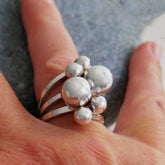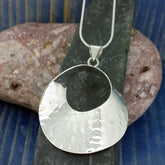What does the Tree of Life mean?
Tree of Life in Mexico
The Tree of Life is a widely recognised and iconic design used across continents, cultures and religions, including Mexico. It’s so ancient that depending on who you ask, you’ll get a different meaning. What we can be sure of, however, is its resplendent and bountiful image is full of life. In this article we’ll explain what we’ve learned about the Tree of Life in Mexico, and our interpretation of the meaning of the tree of life in jewellery.
The rich history of silversmiths in Taxco and Mexican heritage is only part of what made Silver Bubble fall in love with this wonderful place. The culture and folk art that enlivens every street and doorway is what hits you when you first step out to explore. With ancient origins dating back to the time of the Maya, Aztecs and beyond, it’s understandable why the iconic yet mystical Tree of Life design is popular, and in particular in jewellery design.
It all started with a lump of clay… below is a modern Tree of Life design incorporating skeletons, owls, flowers and fruits, and another incorporating many aspects of daily life.

When was the first Tree of Life made?
The Tree of Life in Mexico is believed to date back as far as 300 AD according to scholars, since the discovery of small clay mother goddess figurines representing fertility. The more figurative Tree of Life as we know it is through to soon follow in 692 AD, becoming intricate clay pieces incorporating depictions of Adam and Eve, and as many birds, flowers, leaves and branches as the artisan could include. Serpents and monsters also featured in ancient designs.
This ancient Mayan temple (pictured), tomb for the Maya king, K'inich Janab' Pakal I of Palenque who became King at only 12 years old has Tree of Life Inscriptions within the walls of his burial place, showing just how important the symbol was to the Maya people.

Mayan Temple (tomb for Maya Kind k'inich Janab)

Mayan Temple
Is the Tree of Life a Religious Symbol?
The modern Tree of Life is often a far cry from the religious ceremonies of its ancient counterpart. In Christianity it is the source of eternal life, and tells the story of Adam and Eve and their departure from paradise. These main characters often feature in Mexican designs, being originally created as incense burners. The Tree of Life also appears in Judaism as a figurative term for the Torah, in Islam as the Tree of Immortality, and Hinduism as a divine giver of wishes. In Chinese Mythology the tree of life produces a peach every three thousand years, giving immortality to the person who eats it. A pretty diverse set of beliefs.
The Meaning of the Tree of Life in Mexico
In Ancient Mexico, symbolic religious art touched on almost every part of life. The high temple rituals - including human sacrifice - which are so morbidly fascinating, are a big part of Mexican Aztec history. The Tree of Life, Jaguar, Monster and Skeleton were all symbols that played a big part in rituals.
It was the Tree of Life which was often given the most prominent role in rituals, and the Ceiba tree, the rounded shape of which is often chosen for Tree of Life designs, such as our Orbed Arbol de la Vida Pendant which is one of our most popular pieces.
There is a beautiful myth, where seven heavens sit above the earth, one on top of the other, each with a hole in the middle. A Ceiba Tree grows from the centre of the earth, through each layer of heaven until it reaches the highest and seventh heaven, where the Great God lives, and where the spirits of the dead rest for all time.
So it’s no wonder that many believe it to represent love, everlasting life, and creation, given the many theories and numerous animals which appear in Tree of Life designs. What’s interesting is that each aspect of the Tree of Life has a meaning.
Birds and the Tree of Life
A Tree of Life with Birds is a common and prominent design feature, with many of the ancient Gods said to take the form of many different types of bird. Hummingbirds, cockerels, doves, parrots and quetzals all feature and are thought to indicate creation and abundance, the life that breathes from the branches of the tree.
Our Triangular Arbol de la Vida is a small tree of life with birds, featuring a woman with a bird on either side, just like this ceramic version.

Birds and the Tree of Life in Ceramic

Birds in a Silver Triangular Pendant
What does the Serpent mean?
The serpent was an equally prominent figure in the Tree of Life, with its meaning being difficult to determine. One theory is that it represents lightning, a conduit between the spiritual and material. Others link the snake closely with the rain and water God.
The Quetzalcoatl is a cross between snake and bird, thought to be the creator of man and revered as embodiment of life, death and rebirth. The snake image was often a rattlesnake, crossed with a human head or the feathers of a quetzal bird, so appears in lots of different forms - you have to look closely!

Serpent represented in the Tree of Life

Jaguar in the Tree of Life
What about the Jaguar?
The jaguar was believed in Ancient Mexico to be an Earth God, symbolizing the interior of the earth, and therefore darkness and night. Mexicans believed that the jaguar devoured the sun, causing solar eclipse, so was often depicted inside caves or mountains.
The bigger, the brighter, the better.
Most importantly for any Tree of Life sculpture in Mexico, the bigger the piece, the brighter and more colourful, the better. We love these designs (for a while we were a little obsessed with them!) and we are sure you can see why. We hope you’ll agree that whether it’s a painted ceramic sculpture, or a delicate silver ring design, the Tree of Life is a really beautiful collection of symbols.
The Tree of Life features in textiles, sculptures and jewellery, in all shapes and sizes, and our rectangular pendant, triangular pendant and orbed earrings which all feature the ‘Arbol de la Vida’ continue to be popular.
This dancer’s costume features the jaguar and the quetzal feathers, in an elaborate tree of life inspired carnival display!

Aztec Dancer in Tree of Life Inspired Carnival Outfits
The Tree of Life in Jewellery
The wonderful thing about the Tree of Life in Jewellery design is that it can come in so many shapes, styles, sizes and materials. Our Tree of Life jewellery designs are created by Armando, a wonderfully skilled silversmith who weaves beautiful birds into our designs, along with other animals, maize leaves and little figures. We particularly love this rectangular design made from two sections. We’ve known Armando for many years, and still delight in his wonderful designs.
There are so many more aspects to the Tree of Life than we can discuss here, but we hope this has enriched your understanding of the Mexican culture and history, and that you’ll continue to love this intricate, beautiful design even more.
You can discover Armando’s collection here - we hope you’ll love it as much as we do.
Shop the Tree of Life Collection today!






